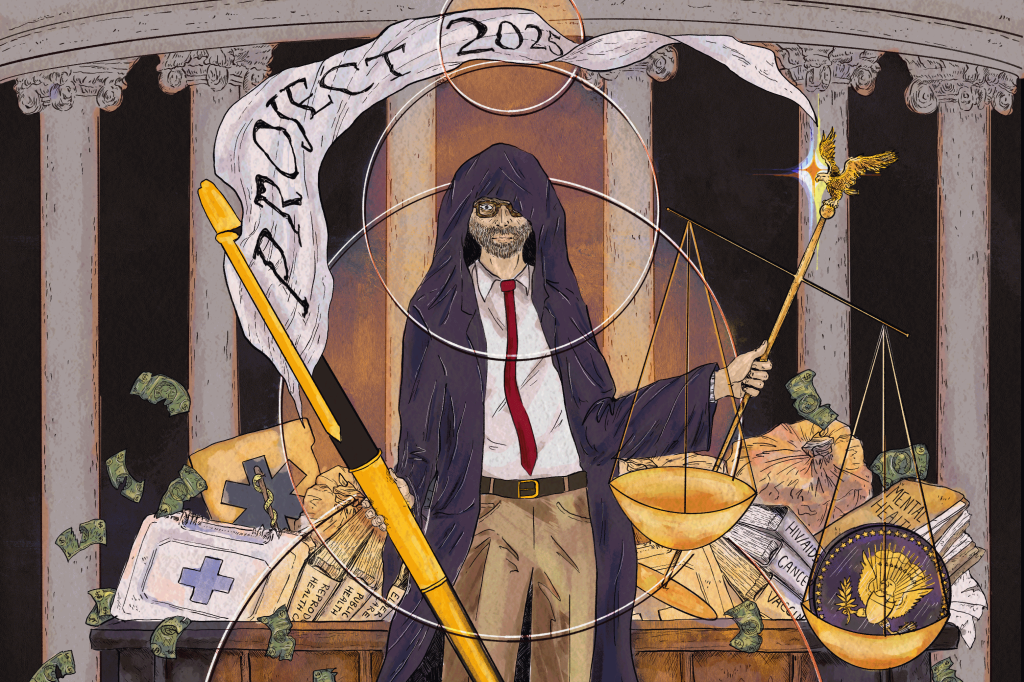The satirical music video featuring a grim reaper-like Russell Vought, the President’s budget director, felt disturbingly accurate to those working on the front lines of public health. It wasn’t just political commentary; it hinted at a quiet, yet powerful, shift in how the nation’s money was being controlled.
Vought had begun to exert unprecedented control over government spending, effectively bypassing Congress and dictating how funds were allocated. This wasn’t a sudden event, but a calculated series of actions – layoffs, canceled grants, and withheld funds – that steadily eroded the financial foundation of vital public health programs.
The consequences were already being felt across the country. Funding cuts crippled outbreak responses, leaving communities vulnerable. Essential medical care was delayed for those living with HIV. Projects designed to address critical issues like raw sewage contamination and maternal mortality were simply abandoned.

The administration’s actions rivaled even the Department of Health and Human Services Secretary in their ability to disrupt government-led health initiatives. In Texas, crucial CDC funds to combat a measles outbreak arrived too late, after two children had tragically died. The situation underscored a chilling reality: bureaucratic delays were costing lives.
Legal experts warn this represents a fundamental challenge to the constitutional balance of power. The “power of the purse” is traditionally held by Congress, allowing them to shape and direct policy. Vought’s tactics, outlined in a conservative blueprint known as Project 2025, were designed to wrest that power away.
These tactics unfolded subtly, often unnoticed by the public. Abrupt grant cancellations, restrictive spending conditions, and excessive layers of review became commonplace. The process of securing funds was further hampered by staffing cuts, leaving agencies depleted and overwhelmed.
Government employees, increasingly alarmed, began to voice their concerns to members of Congress. They described a system designed to prevent states and communities from performing essential public health work, ultimately jeopardizing the safety of the nation. The lack of capacity, they warned, would have far-reaching consequences.
While Democrats on appropriations committees demanded transparency, the full extent of the unspent funds remained unclear. A deliberate strategy was emerging: allowing money to lapse, then arguing that the lack of spending justified further cuts. It was a calculated maneuver with devastating potential.
The administration’s actions were often shrouded in secrecy, fueled by a climate of fear. Federal offices responsible for accountability were defunded or threatened, and whistleblowers faced retribution. Local governments and organizations found their funding abruptly revoked, leaving them scrambling to maintain essential services.
Vought himself publicly framed this shift as a necessary “deconstruction of the administrative state,” arguing that federal agencies and Congress had become “woke and weaponized.” He saw his role as restoring control to the executive branch, a vision rooted in a desire to dismantle decades of established practices.
The federal budget process, already complex, was being systematically undermined. Through the Office of Management and Budget and a newly created entity, the Department of Government Efficiency, the administration intervened at every stage, creating a cascade of obstacles.
Traditionally, Congress appropriates funds to agencies, which then solicit applications from states, local governments, and organizations. Agency experts select recipients, and funds are disbursed. But the Trump administration disrupted this process, canceling billions in awarded grants and clawing back funds earmarked for critical programs.
Beyond these large-scale cancellations, a more insidious tactic emerged: a slow, deliberate freezing of funds. Agencies were subjected to excessive scrutiny, forced to navigate a labyrinth of red tape. Even routine expenses were questioned, creating a climate of uncertainty and paralysis.
The CDC’s HIV and tuberculosis prevention center, for example, distributed $167 million less than usual. Funding for chronic disease prevention, HIV/AIDS programs, and mental health services also lagged significantly behind expectations. An unknown amount of allocated funding remained unawarded, poised to lapse at the end of the fiscal year.
A key tactic involved apportioning funds in smaller installments, giving the OMB greater control over the timing and flow of money. This delayed agencies’ ability to approve spending, effectively putting projects on hold. The administration also imposed conditions on apportionments, requiring alignment with its priorities, often targeting programs focused on diversity, equity, and inclusion.
Organizations reliant on federal funding faced unsettling questions and crippling delays. A Mississippi nonprofit was asked to justify excluding men from a domestic violence shelter program. Across the country, grantees struggled to reach program officers as federal workers were laid off, further exacerbating the chaos.
The consequences were tangible and heartbreaking. A measles outbreak in West Texas raged for weeks before federal funding arrived. HIV clinics were forced to lay off staff and reduce hours. Food banks canceled events. The ripple effects extended to countless communities, impacting the most vulnerable populations.
Condoms, a vital tool in preventing the spread of sexually transmitted infections, were removed from distribution in Louisiana due to funding shortages. In a state already grappling with high rates of HIV, chlamydia, and gonorrhea, this decision felt particularly reckless. The long-term costs of treating these diseases far outweighed the cost of prevention.
Nationwide surveys tracking maternal and infant mortality were frozen for months, creating an irrecoverable gap in critical data. The administration was, in effect, rewriting the rules, circumventing Congress and dictating policy through administrative control. It was a dangerous precedent, one that threatened the very foundation of American governance.
Even routine reimbursements were subjected to intense scrutiny, requiring multiple layers of approval for even the smallest expenses. The Department of Government Efficiency scrutinized itemized expenses, questioning costs as low as a dollar. This level of micromanagement was unprecedented and deeply disruptive.
As the fiscal year drew to a close, many funding solicitations were delayed or never issued at all, leaving organizations scrambling to secure resources. Housing assistance programs faced imminent cuts, threatening to displace vulnerable individuals and families. The administration appeared to be executing its future budget requests through administrative controls, effectively predetermining outcomes.
The situation was described as “boring but crazy-high stakes,” a one-branch veto of spending that undermined the constitutional checks and balances designed to protect the power of the purse. It was a quiet revolution, unfolding beneath the radar, with potentially devastating consequences for the health and well-being of Americans.





